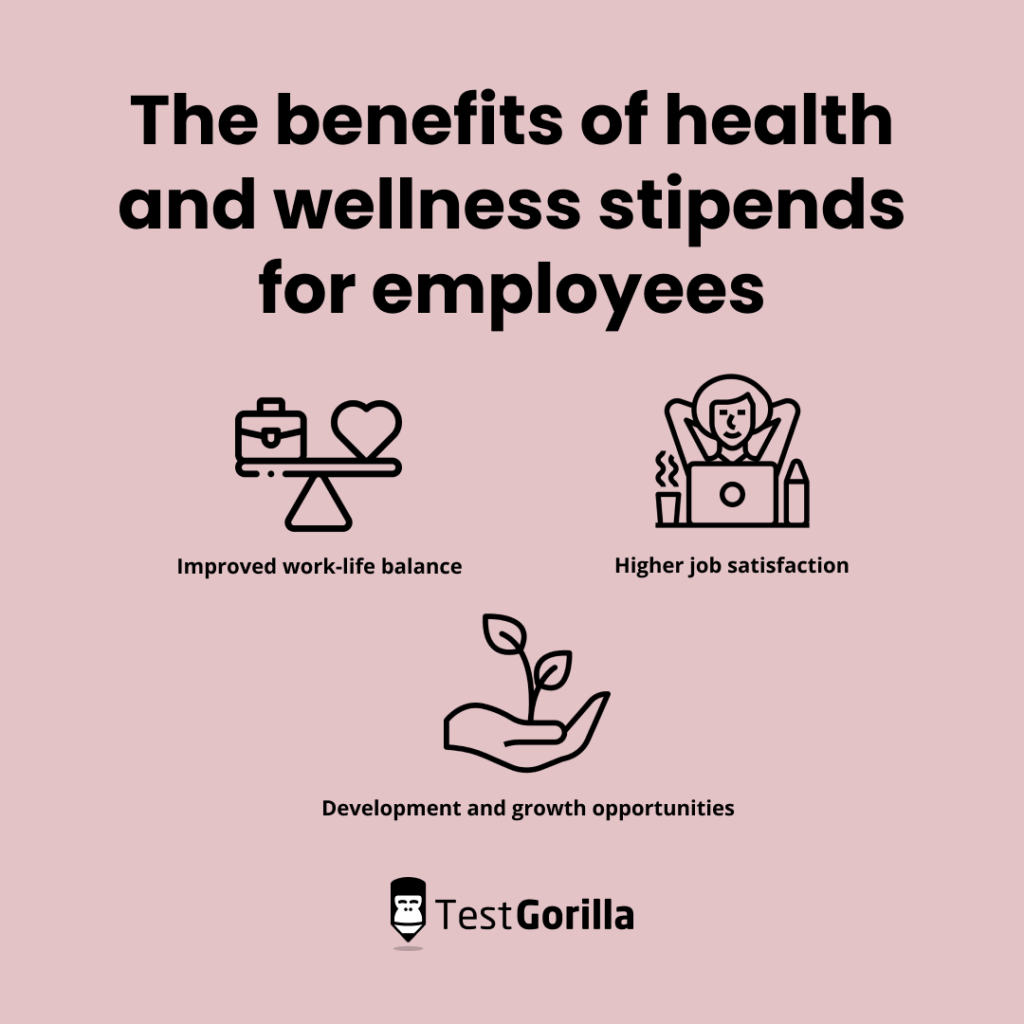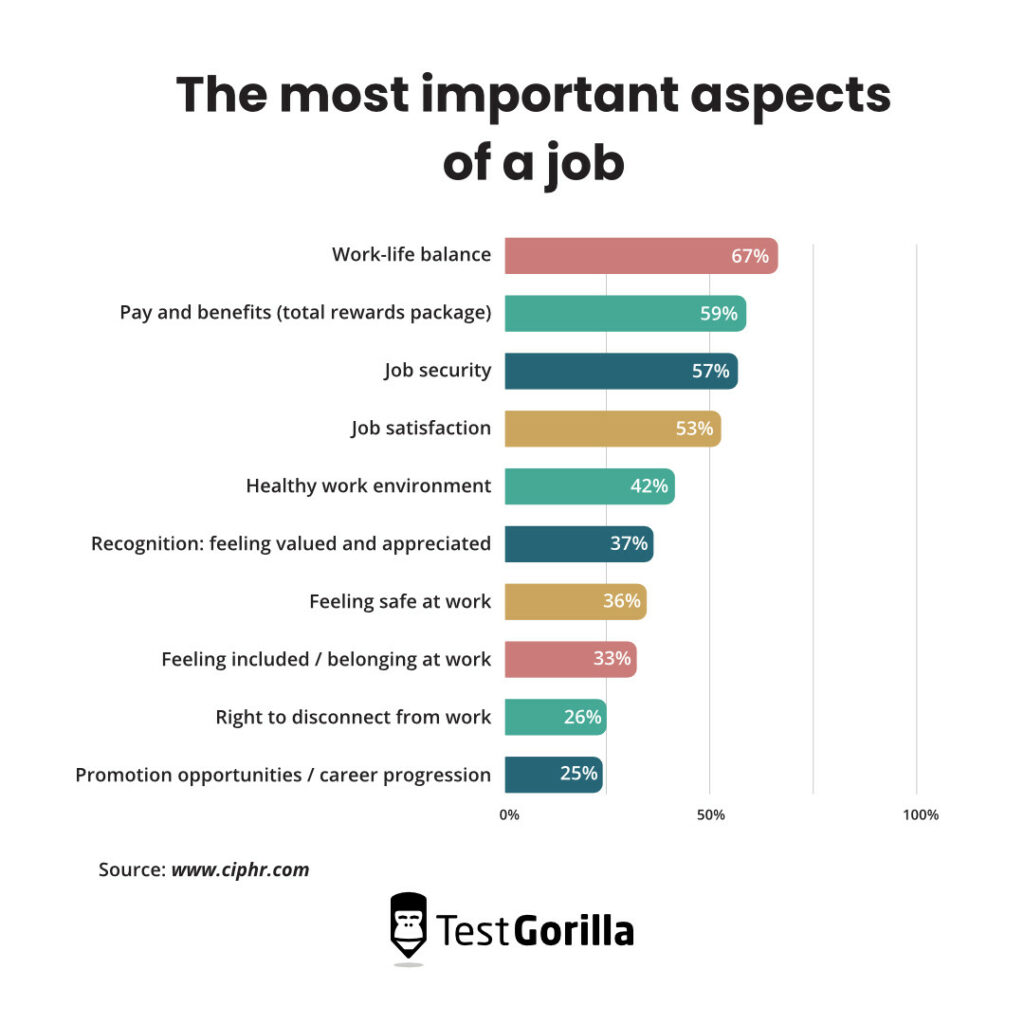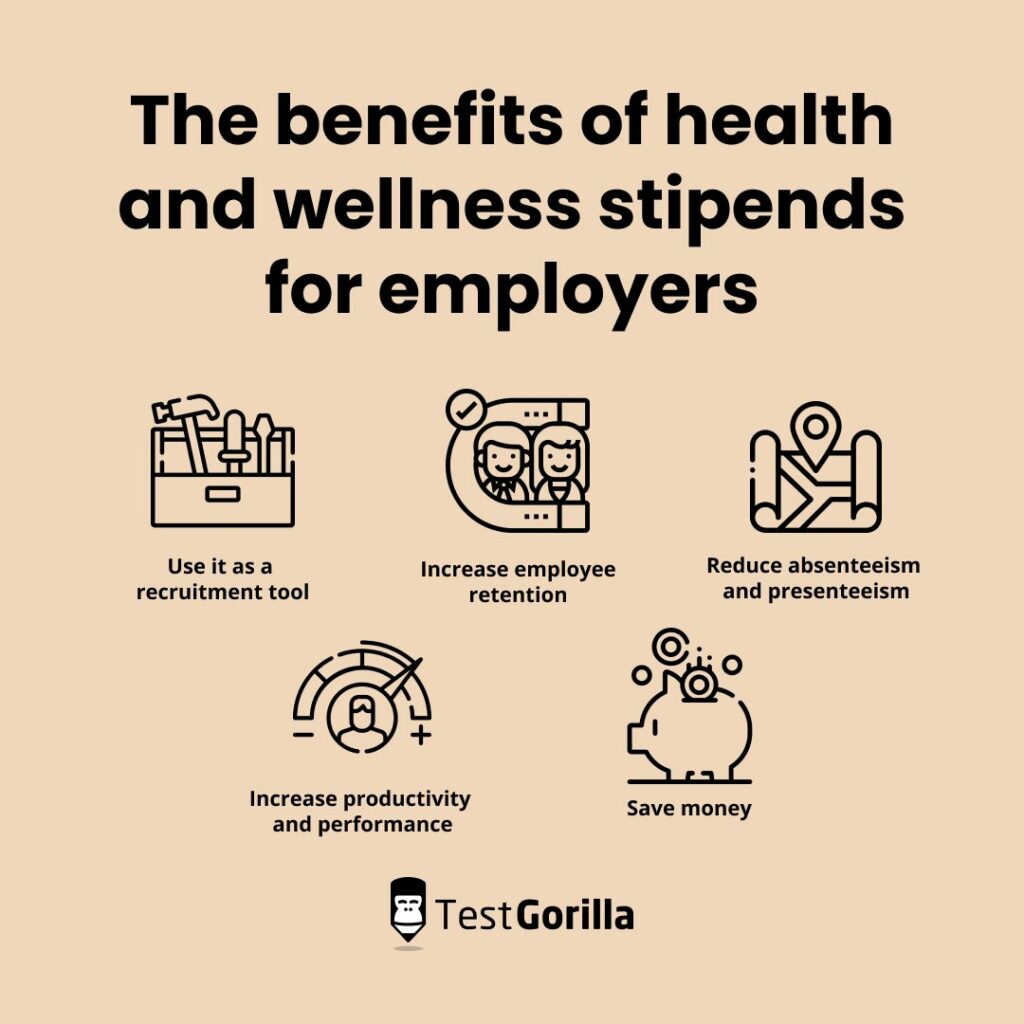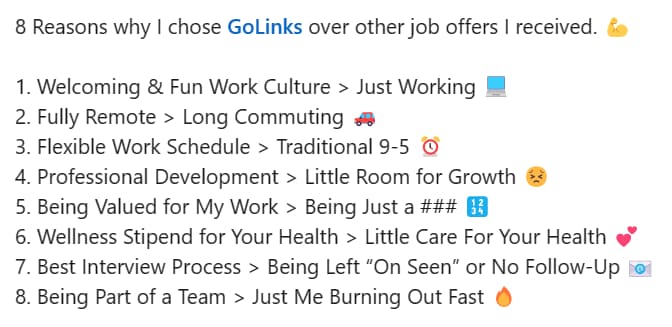With the peak of Covid-19 barely behind us, candidates are re-entering the workforce with a new, profound awareness of the importance of their wellbeing.
Now that mandatory lockdowns are over and the gloves are coming off, you have the opportunity to show where your company stands.
Do you truly care about the health of your employees? Or are you just doing the legally required bare minimum?
The answer should be the first one, of course. The candidate with the right skills has to be sold on your company as much as you are sold on them, so it’s not enough to find them.
You have to convince them you’re their best potential employer – the employer that truly cares about them as a person, not just a worker.
Offering meaningful and non traditional benefits is one of the most significant ways to secure and retain top talent.
One survey indicated that 58% of employees prioritize benefits specifically related to mental and physical health such as wellbeing allowances, access to online therapy, and private healthcare.[1]
Cue wellness reimbursement.
In this article, we explain how this benefit works and how to execute it to make the biggest difference in your employees’ lives while also attracting talented candidates.
Table of contents
- What is a health and wellness reimbursement?
- Why are wellbeing allowances important in today’s workplace?
- The benefits of health and wellness stipends
- What expenses should health and wellness stipends cover?
- 5 top tips for implementing a wellness reimbursement program
- What else should you do to combat burnout and improve employee wellbeing?
- Secure and retain top talent with wellness reimbursement
- Sources
What is a health and wellness reimbursement?
Wellness reimbursement, also called a wellness stipend or wellness allowance, is money that employees are offered on a regular basis, typically once per calendar year, intended to cover the expenses related to their wellbeing. It can include gym memberships, therapy sessions, mental health apps, or other similar expenses.
A “wellness stipend” and a “health stipend” can mean slightly different things.
Health stipends tend to cover strictly medical expenses, like doctors’ appointments.
Wellness stipends cover activities and expenses that aren’t necessarily medical but are related to staff wellbeing or mental health. They can include fees related to exercise or sports, meditation and sleep apps, therapy, yoga courses, or exercise equipment.
The amount of money given in a wellness reimbursement can range from a couple hundred to thousands of dollars, but the idea is the same:
Take some of the burdens off your employees’ shoulders and support their wellbeing.
With this benefit, you encourage employees to invest in their health and happiness and ensure that, no matter how they wish to allocate their salary, they have a sum of money specifically meant for wellbeing-related expenses.
Why are wellbeing allowances important in today’s workplace?
We spend a lot of our time working.
Whether that’s commuting and sitting in an office, working from a makeshift workstation at home, or even just thinking about work, the way we spend our time with a company impacts our wellbeing both physically and mentally.
Common examples include prolonged sitting contributing to a sedentary lifestyle and the emotional drain caused by pressure to perform well.
There are two work-related aspects that directly influence our health:
Workplace environment
Socioeconomic factors
The workplace environment is all about an employee’s time and experience working for the company:
Does the culture encourage frequent breaks and mental health days?
Do coworkers work as a team, respect one another, and support each other?
Does work end when it ends, or is there pressure on staff to stay available for work-related comms 24/7?
Do employees have time and energy to devote to exercise?
Do they have education or resources to learn about managing a healthy lifestyle?
The amount of attention your company pays to wellness can make or break your employees’ experience, health, job satisfaction, productivity, and desire to stay with the company.
Work outcomes, client satisfaction, and profitability all hinge on a healthy workplace environment.
The second aspect to consider, socioeconomic factors, is related to money.
Specifically, how much employees earn, their income stability, what they can realistically do with that money, and how that influences their wellbeing.
Imagine you’re living paycheck to paycheck, barely making ends meet.
You’re probably going to spend your salary on the bare necessities like bills and food, right? You definitely won’t be going to the sauna or dropping it on a Peloton.
Wellness activities and costs won’t make your list of top priorities, and you might even be spending your “free time” working at a second job or looking for further opportunities.
Not only is this robbing people of opportunities to maintain optimal health, but it’s also actively damaging it.
All that stress weighs heavy on an employee’s shoulders and can cause a devastating ripple effect. It’s common knowledge that mental and physical health are closely interlinked.
Neglecting one aspect increases your risks with the other, so it’s fundamental to treat both as equally important.
As the employer, both environmental and socioeconomic factors need to be on your radar.
Here are some ways a lack of care for employee wellbeing plays out:
Remote workers experience depression due to being disconnected from coworkers, not having a clear separation between personal and work lives, developing poor eating habits, and lacking physical activity
Workplace anxiety develops due to a toxic or competitive culture at work, staff shortage, unrealistic employer expectations, and employers not prioritizing wellbeing and safety at work[2]
Mental health issues can easily be missed if the employer focuses their policies on physical health only, increasing an employee’s risk of disease anyway
Stress can cause high blood pressure, which increases the risk of heart failure
These issues are correlated and often snowball if you don’t cut them at the start.
People who aren’t healthy have a big enough worry to think about: getting better. They can’t focus on putting in their best work or impressing their manager even if they want to – their productivity level, focus, problem-solving skills, and resilience to stress are all tanked.
Wellness reimbursement is one of the strategies that help both short- and long-term because it can be flexible to an employee’s needs in regard to both physical and mental health.
With a monthly or yearly allowance specifically dedicated to their wellbeing, employees can take steps to stay active and prevent health issues.
The benefits of health and wellness stipends
Below are the main advantages of offering this benefit to your staff, both from their and your perspective.
Benefit for employees 1: Improved work-life balance
Many workers consider work-life balance to be more important than pay and other benefits combined.
But it’s a somewhat vague concept, so let’s define it.
Work-life balance means that work doesn’t soak up all of an individual’s energy and time as the sole priority.
In terms of daily life, that means…
Finishing work without feeling incapacitated by mental drain
Having the time and energy to be active
Consistently getting enough quality sleep
Spending plenty of quality time with family and friends
Having access to therapy or medication
Having access to education about health and wellness
Having resources to meet all needs
Minimizing stress and other risk factors for disease
Turning wellness practices into habits instead of rare luxuries
Wellness reimbursement is a huge step towards making work-life balance the new business as usual because it guarantees employees can take the steps to focus on where that balance really lies.
While you’re at it, take a look at the rest of the priority list for candidates and how many of these aspects you improve by offering a wellness stipend:
We see at least six other targets on this list you can hit with wellness reimbursement and other wellness initiatives, how about you?
Benefit for employees 2: Higher job satisfaction
Sure, you can’t promise any position will be anyone’s dream job, per se.
But, offering wellness stipends and other non traditional perks can make you the dream company to work for and make employees glad to be there.
The reason is simple: The benefits extend past the job itself.
The sum that the wellness stipend covers for staff is the sum they can reallocate to other meaningful activities and opportunities they otherwise wouldn’t be able to access.
Wellness reimbursement helps employees in their personal lives by going toward:
Fitness equipment for working out at home, like yoga mats or dumbbells, to make it easy to stay active
Ergonomic chairs and similar changes to make the office area healthier so employees don’t routinely finish work with stiff “desk job backs” they need to recover from
Nutrition and cooking ebooks to simplify healthy eating and help integrate it as a habit
Access to peer-to-peer support and therapy enable employees to open up about difficulties and trauma in a safe space and get the support to overcome them
Wellbeing allowance helps staff feel and show up as their best selves.
Considering how inaccessible therapy and other resources can be, giving employees wellness stipends can be life-changing.
Benefit for employees 3: Development and growth opportunities
Increased productivity and motivation as a result of wellness stipends can skyrocket employees’ careers.
They can put their best work in to get the recognition they deserve and still have the energy left to develop new skills on the job and go for promotions.
Knowing your career has a future in the company is a good reason to stick around. It’s also an incentive to go the extra mile and make that future a reality.
Goodbye, quiet quitting.
Benefit for employers 1: Use it as a recruitment tool
Wellness reimbursement is an indicator of a people-first workplace that prioritizes staff health and wellbeing.
Companies that provide wellness benefits make it easier on talent to identify them as great places to work.
Candidates say so themselves:
These are by no means selfish requests.
Everyone deserves to feel valued, have access to resources to maintain good health, and like the lives they lead.
And, if we imagine two ads for identical roles and pay, the one that offers better benefits will win over more candidates and have the first pick.
A wellness stipend helps you stand out as that kind of company.
Benefit for employers 2: Increase employee retention
Research shows that 61% of employees feel burnt out.
Burnout happens when work-life balance becomes compromised and the problem isn’t addressed until it’s too late. The aftermath and recovery can last long – months, even years.
This is detrimental to your employees’ health and ability to work.
But you can help prevent burnout with a wellness stipend.
Employees can afford the care they need and sustainably integrate healthy practices into their lives to alleviate early symptoms.
A wellness stipend proves you care even after the onboarding honeymoon is over and gives employees a reason to be loyal to your company.
Of course, this only works if you’re already paying employees fairly.
Wellness reimbursement should represent additional help as a supplement to the salary.
If your employees have to find a second job to sustain themselves, an allowance won’t be enough to meet their needs or convince them to keep their position. It should push them beyond what it takes for them to live “comfortable” lives.
Benefit for employers 3: Reduce absenteeism and presenteeism
Presenteeism happens when workers show up for work for the sake of it and aren’t necessarily productive.
For example, they have a cold and need to rest but they couldn’t afford to take a sick day so they’re just sitting there, not doing much.
On the flip side, absenteeism is a pattern of absence from work without a solid reason not to show up.
Both present issues for employers. Naturally, both correlate with employee wellbeing.
Wellness allowance can help you combat the core issue.
It seems that companies with solid wellness programs in place reduce both absenteeism and presenteeism incidents because employees take fewer days off and make better use of their time “on” the job.
Benefit for employers 4: Increase productivity and performance
In another survey, 83% of employers said their wellbeing program positively affected employee health, and 84% said it increased staff productivity and performance.
We aren’t surprised.
When people rest and refuel on a regular basis, they’re better able to focus and meet high-quality standards compared to when they’re sleep deprived and stressed.
A wellness stipend as part of a wellbeing program contributes to better performance on a company level, which leads to better outcomes and satisfied clients.
Benefit for employers 5: Save money
Look at it like an extra layer of health insurance: You pay a small amount regularly to avoid a big expense down the road.
Wellbeing allowance is a long-term bargain because it helps with prevention.
You lower the risk of employees developing conditions such as heart disease, type 2 diabetes, and even cancer with wellness programs, so by giving allowance now, you lower your total costs for covering them later.
Now, let’s strategize your approach.
What expenses should health and wellness stipends cover?
Here are some types of expenses you could include in your stipend:
Babysitting and childcare
Fitness and sports equipment
Home exercise equipment
Personal training and gym memberships
Massages
Nutritionist services
Quitting smoking programs
Yoga and aerobics classes
Better office equipment
Chiropractic care
Vision costs
Preventative screenings and tests
Kitchen equipment
Healthy food stores and food allowances
You can customize your offer based on these ideas.
Some companies go above and beyond to include art supplies, language classes, musical instruments, pet care, and more.
There’s no reason to rely on blind guesses alone – you can ask your employees what wellness services they’re already using and what else they’d like so you can include it.
Maybe they’re already in therapy or yoga classes but would appreciate you taking over the costs.
To create the most effective and relevant plan, consider the rest of your perks and your company as a whole.
If you already have another benefit that overlaps with wellness stipends, you could remove the mutual part between them and focus on adding more options
For example, Facebook’s gym and wellness reimbursement can also be used for child care reimbursement.
Microsoft’s wellness reimbursement doesn’t include child care. However, they have a separate babysitting allowance to cover up to 160 hours per year to support working parents.
The most important thing is that your wellness initiatives come together as a holistic plan to care for staff.
The way you handle the logistics is up to you. But don’t worry, we’ll help you figure it out.
5 top tips for implementing a wellness reimbursement program
Use these tips as guidance to ensure your wellbeing allowance pans out and truly takes care of your employees.
Summary of wellness reimbursement program tips
Tip | Key points |
Work on a supportive workplace culture and reduce stigma around mental health | Create an open dialogue about mental health and provide resources; Train and hire supportive managers to help you facilitate a safe atmosphere |
Communicate the program clearly and make it easy to claim a reimbursement | Make it clear what’s covered and what’s not to avoid disappointment |
Make sure your allowance is reasonable and enough to cover key wellness expenses | Take a look at the average cost of activities and things you want to cover; For US-based companies, $1,000-$1,500 is a good ballpark to aim for |
Track your initiatives and make sure you’re covering the activities/equipment your staff wants | Survey employees to see what they truly need; Keep an ear out and adjust over time as answers might change |
Don’t think an allowance is enough on its own to combat burnout and stress on the job | Work on company culture; Implement other parallel non traditional benefits |
1. Work on a supportive workplace culture and reduce stigma around mental health
A supportive culture is a cornerstone of employee health.
You want staff to be comfortable enough to talk about their problems so they can access the help they need instead of bottling it up in secret.
The worst case scenario is that you provide wellness stipends that people don’t end up using because they want to hide their mental health problems or needs.
Everyone deserves to be understood and supported. So, here are some steps to create a healthy culture that enables that:
Reduce stigma around mental health by asking and talking about it
Make sure all employees have resources to learn about mental health topics
Train and hire supportive managers to help you facilitate a safe atmosphere, reduce psychological stress for employees, and model the right behavior
Hire “culture-adding” instead of “culture-fitting” employees to naturally diversify your workplace
Add soft skills like direct and kind communication and teamwork in your recognition and promotion metrics
2. Communicate the program clearly and make it easy to claim a reimbursement
Make it clear what’s covered and what’s not.
This helps to avoid disappointment and empowers employees to make informed decisions in their best interest.
Imagine your company covers nutritionist services and your employees who need it don’t know they have access to it. Or, an employee accepts an offer from a company they think has better benefits just because they’re unaware you offer them as well.
Communicating clearly and on time guarantees that there’s no confusion between you and your employees.
3. Make sure your allowance is reasonable and enough to cover key wellness expenses
Wellbeing allowances drastically vary from company to company:
Sony | $480 per year ($40 per month) |
Klarna | $360 per year |
Salesforce | $1200 per year ($100 per month) |
Stripe | $3000 per year ($250 per month) |
Atlassian | $600 per year |
$5000 per year |
However, unless you have a plethora of other programs and benefits that somehow make up for it, like on-site gym and fitness classes, employee assistance program, or Microsoft’s babysitting allowance – a small wellbeing reimbursement might not cut it.
Think of the healthcare and activity costs you need to cover:
Babysitting costs parents $20 per hour
Gym memberships cost around $58 per month
Weight loss programs cost $10-$25 per day
Nutritionist services cost between $100-$200 per visit
Not to mention the healthcare costs in the US at a whopping $12,318 per person on average.
Spending $100 a year for US-based employees is unlikely to make a real difference.
Think more in a $1,000 or $1,500 ballpark.
4. Track your initiatives and make sure you’re covering the activities and equipment your staff wants
Your allowance needs to cover relevant things or it will be as useful as that ping-pong table collecting the office dust.
Survey employees to find out what they truly need.
Then? Keep listening after you implement the policy.
Sometimes the real answers get revealed over time.
When a new popular request pops up, consider adding it to replace the least-used item on the list.
5. Don’t think an allowance is enough on its own to combat burnout and stress on the job
A wellness stipend is just one part of the equation.
The workplace health model is a holistic plan that includes multiple initiatives.
You can use the Centers for Disease Control and Prevention’s workplace health plan checklist to help you with planning a holistic wellness offering.
But we have some ideas about what else you can do below.
What else should you do to combat burnout and improve employee wellbeing?
A wellbeing allowance isn’t a substitute for other complementary ways to boost employee health you need in your wellness program.
So, to make sure you’re not just reaching for a band aid solution, here’s what else you should do to make health and wellness an integral part of your business.
Pay people fairly: 2 in 3 employees don’t make enough to save for emergencies and 34% can’t afford healthcare-related costs
Offer flexible options: 90% of employees were as productive or more since working from home, 84% say that WFH would make them happier, and 82% say WFH is better for their mental health[3]
Prioritize mental health-related benefits: Consider making trade-offs with current benefits to make room in the budget – Netflix subscriptions are not as crucial to staff
Consider a 4-day workweek: Fewer work hours are associated with higher life satisfaction and employees can focus on their performance and engagement, not on the time spent sitting at the desk[4]
Hire and train supportive managers: Use pre-employment tests to identify the soft skills required for empathetic leadership and teach managers how to embody the right behaviors and recognize employees
TestGorilla offers unlimited PTO and free wellness sessions every three weeks for staff as a way to promote health in the workplace.
Secure and retain top talent with wellness reimbursement
Wellness reimbursements are only getting more popular as part of holistic wellbeing initiatives.
That’s because they make a real difference in your employees’ lives that goes beyond the job itself, genuinely making your company a better place for work.
Wellness stipends are also a good way to attract a large and diverse talent pool.
You can proceed to sift your applicants with a Culture Add test to avoid echo chambers and identify the right addition to your company.
Learn more about benefits and compensation to create an offer that’s hard to refuse and win over the right person for any role.
Sources
Related posts
Hire the best candidates with TestGorilla
Create pre-employment assessments in minutes to screen candidates, save time, and hire the best talent.
Latest posts
The best advice in pre-employment testing, in your inbox.
No spam. Unsubscribe at any time.

Hire the best. No bias. No stress.
Our screening tests identify the best candidates and make your hiring decisions faster, easier, and bias-free.
Free resources
This checklist covers key features you should look for when choosing a skills testing platform
This resource will help you develop an onboarding checklist for new hires.
How to assess your candidates' attention to detail.
Learn how to get human resources certified through HRCI or SHRM.
Learn how you can improve the level of talent at your company.
Learn how CapitalT reduced hiring bias with online skills assessments.
Learn how to make the resume process more efficient and more effective.
Improve your hiring strategy with these 7 critical recruitment metrics.
Learn how Sukhi decreased time spent reviewing resumes by 83%!
Hire more efficiently with these hacks that 99% of recruiters aren't using.
Make a business case for diversity and inclusion initiatives with this data.























